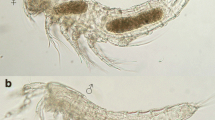Abstract
Two known and two new species of Diplectanocotyla Yamaguti, 1953 (D. gracilis Yamaguti, 1953, D. megalopis Rakotofiringa & Oliver, 1987, D. langkawiensis n. sp. and D. parva n. sp.) were collected from Megalops cyprinoides (Megalopidae) off Langkawi, Kedah and Matang, Perak, Peninsular Malaysia. All four species possess similar types of sclerotised male and female reproductive structures and similar soft anatomical features. The squamodisc sclerites of all four species have spine-like projections with varying degrees of visibility and shapes (sharp-pointed to triangular). In D. megalopis and D. langkawiensis n. sp. the spines are sharp-pointed and distinct on sclerites from rows 5–6 onwards. In D. gracilis and D. parva n. sp. the sclerite spines are triangular, lightly sclerotised and occur on almost all of the sclerites. D. parva n. sp. has comparatively the smallest set of anchors, bars, squamodiscs and squamodisc suckers. The anchors and bars of the other three species are almost similar in overall size, and the main distinguishing feature is the relative lengths of the inner and outer roots of the ventral anchors. In D. gracilis the outer root is very much smaller than the inner root and they are disposed almost at a right angle to each other. In D. megalopis the outer root is usually about half the length of the inner root and the roots are inclined at c.60° to each other. In D. langkawiensis n. sp. the roots are inclined at c.40° degrees and the outer root is of a similar length or only slightly shorter than the inner root. The openings of the two squamodisc suckers of all four Diplectanocotyla species are surrounded by tiny scale-like spines. Bifid tegumental spines are found in the posterior region of all four species, differing only in their extent: in D. parva n. sp. the tegumental spines are only distributed in the peduncular region and not beyond, whilst in the other three species the tegumental spines extend from the posterior level of the testis to the end of the peduncle. An amended diagnosis of Diplectanocotyla and a key to its species are appended.
Similar content being viewed by others
References
Bunkley-Williams, L., & Williams, E.H., Jr. (1994). Parasites of Puerto Rican freshwater sport fishes. San Juan, Puerto Rico: Puerto Rico Department of Natural and Environmental Resources; and Mayaguez, Puerto Rico: Department of Marine Sciences, University of Puerto Rico, 168 pp.
Froese, R., & Pauly, D. (Eds) (2006). FishBase. World Wide Web electronic publication. http://www.fishbase.org, version (03/2006).
Lim, L. H. S. (2006). Diplectanids (Monogenea) on the archerfish Toxotes jaculatrix (Pallas) (Toxotidae) off Peninsular Malaysia. Systematic Parasitology, 64, 13–25.
Mendoza-Franco, E. F., Kritsky, D. C., Vidal-Martinez, V. M., Scholz, T., & Aguirre-Macedo, M. L. (2004). Neotropical Monogenoidea. 45. Revision of Diplectanocotyla Yamaguti, 1953 (Diplectanidae) with redescription of Diplectanocotyla megalopis Rakotofiringa and Oliver, 1987 on Atlantic tarpon, Megalops atlanticus Cuvier and Valenciennes, from Nicaragua and Mexico. Comparative Parasitology, 71, 158–165.
Rakotofiringa, S., & Oliver, G. (1987). Révision du genre Diplectanocotyla Yamaguti, 1953 avec description d’une espèce nouvelle et création de la famille des Diplectanocotylidae nov. fam. (Monogenea, Monopistocotylea). Bulletin du Museum National d’Histoire Naturelle, Paris, 9, 333–339.
Yamaguti, S. (1953). Parasitic worms mainly from Celebes. Part 2. Monogenetic trematodes of fishes. Acta Medica Okoyama, 8, 203–256.
Yamaguti, S. (1963). Systema helminthum. (Vol. IV). Monogenea and Aspidocotylea. New York: Interscience Publishers, 699 pp.
Acknowledgements
We would like to thank Dr Antoine Pariselle for helping with the French literature, Mr K.S. Liew for his excellent technical assistance and Mr W.L. Wong and Mr WB Tan for help in preparing the specimens for SEM. We would also like to thank the following people and museums for the loan of specimens in their care: Dr Jun Araki of the Meguro Parasitological Museum, Tokyo; Prof. Jean-Lou Justine and Dr Jimmy Cassone of the Museum National d’Histoire Naturelle, Paris; and Dr F. Moravec of the Institute of Parasitology, Czech Academy of Sciences. We are also grateful to Prof. Justine for help with Adobe Illustrator and the use of his ‘eyes’ and ‘vitelline swatch’. This study is part of a larger study funded by a Fundamental Research Grant (FP007/20038) from the University of Malaya, Kuala Lumpur.
Author information
Authors and Affiliations
Corresponding author
Rights and permissions
About this article
Cite this article
Lim, L.H.S., Gibson, D.I. Diplectanocotyla Yamaguti, 1953 (Monogenea: Diplectanoidea) from Megalops cyprinoides (Broussonet) (Teleostei: Megalopidae) off Peninsular Malaysia. Syst Parasitol 67, 101–117 (2007). https://doi.org/10.1007/s11230-006-9075-1
Received:
Accepted:
Published:
Issue Date:
DOI: https://doi.org/10.1007/s11230-006-9075-1




